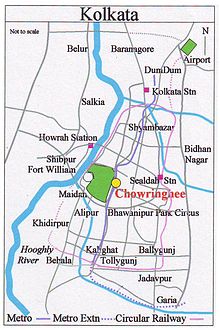Chowringhee
| Chowringhee | |
|---|---|
| Neighbourhood in Kolkata (Calcutta) | |

Chowringhee skyline 2011
|
|
 |
|
| Coordinates: 23°48′N 88°15′E / 23.8°N 88.25°ECoordinates: 23°48′N 88°15′E / 23.8°N 88.25°E | |
| Country |
|
| State | West Bengal |
| City | Kolkata |
| Ward |
|
| Metro Stations | Esplanade, Park Street, Maidan |
| Parliamentary constituency | Kolkata Uttar |
| Assembly constituency | Chowranghee |
| Government | |
| • MLA | Naina Bandopadhyay |
| Elevation | 36 ft (11 m) |
| Population (2001) | |
| • Total | 159,917 |
| Time zone | IST (UTC+5:30) |
| PIN | 700087, 700016 |
| Area code(s) | +91 33 |
Chowringhee (also spelt Chourangi) (Bengali: চৌরঙ্গী) is a neighbourhood in central Kolkata, earlier known as Calcutta, in the Indian state of West Bengal. Jawaharlal Nehru Road (earlier known as Chowringhee Road) runs on its western side. A neighbourhood steeped in history, it is a business district, as well as a shopper’s destination and entertainment-hotel centre.
The name ‘Chowringhee’ has defied etymologists. There is, however, the legend of a yogi, Chourangi Giri, who discovered an image of the goddess Kali’s face and built the first and founded the original Kalighat temple.
In the seventeenth century or prior to it, the area now occupied by the Maidan and Esplanade was a tiger-infested jungle. At the eastern end of it was an old road, which had once been built by the Sabarna Roy Choudhury family from Barisha to Halisahar. Beyond it there were “pools, swamps and rice-fields, dotted here and there with the straggling huts of fishermen, falconers, wood-cutters, weavers and cultivators. In that region were three small hamlets – Chowringhee, Birjee and Colimba.
In 1717, Chowringhee was a hamlet of isolated hovels, surrounded by water-logged paddy-fields and bamboo-groves separated from Gobindapur by the jungle. Tradition has it that Warren Hastings, hunted with elephants in the jungle. Birjee occupied the south-eastern end of later day Maidan, Victoria Memorial and Rabindra Sadan area. Colimba took its name from the Bengali word for musk melon.
The strengthening of British power, subsequent to their victory in the Battle of Plassey was followed by the construction of the new Fort William, in 1758. The European inhabitants of Kalikata gradually forsook the narrow limits of the old palisades and moved to around the Maidan. In the mid eighteenth century Englishmen began to build magnificent houses on the Chowringhee that earned Kolkata the title of ‘City of Palaces’.
...
Wikipedia
